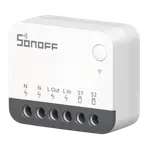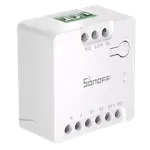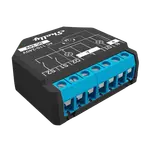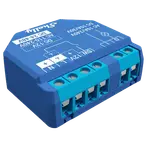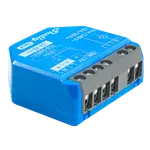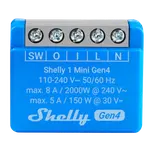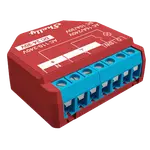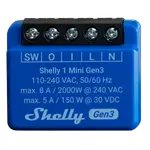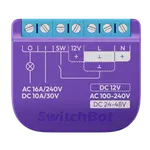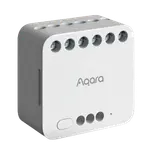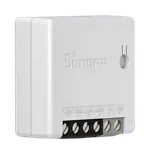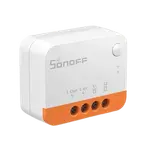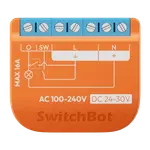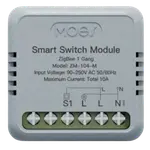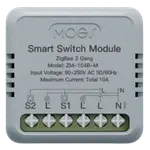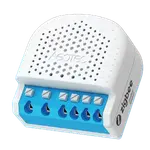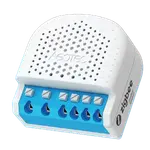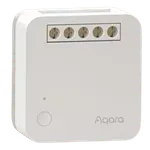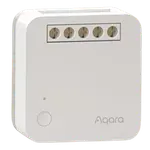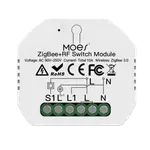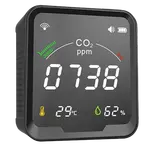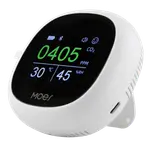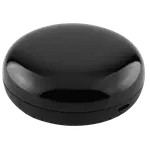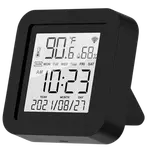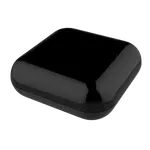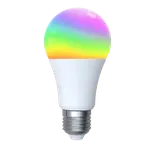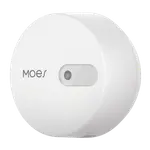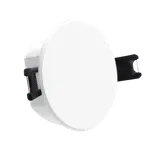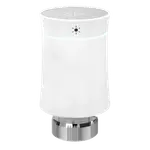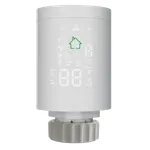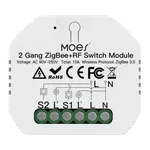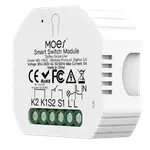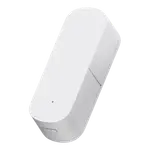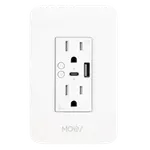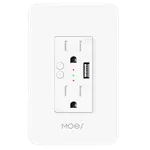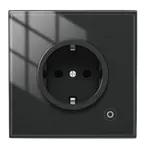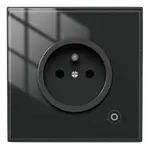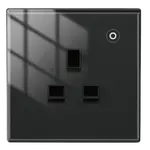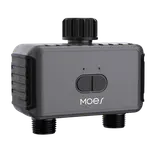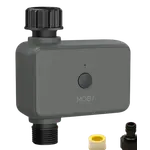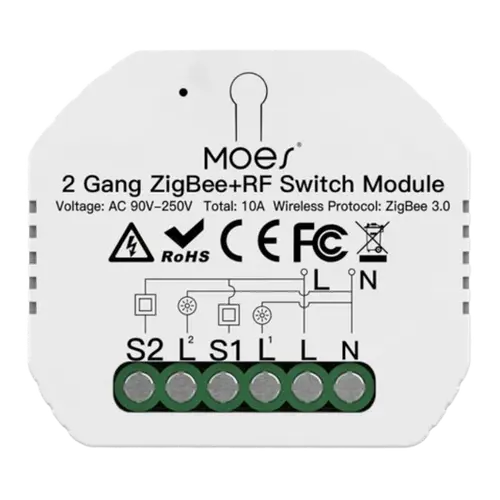
Summary
Size & Materials: 18 x 47 x 52 mm
Power: Neutral Required
Connectivity: Zigbee (Zigbee hub required), Radio Frequency
Integrations: Google Home, Alexa, Home Assistant
Features: Relay Channels (2), Wet Contact Mode, DIN rail mount, Zibgee Router
Price History
Loading price history...
| Brand | Moes |
|---|---|
| Headquarters | |
| Website | https://moeshouse.com |
| @moes_smart |
Size & Materials
Length x Width x Height
- Length: the longest side of the device
- Width: the shorter side of the device
- Height: the vertical dimension of the device
18 x 47 x 52 mm
The physical weight of the device, typically measured in grams (g) or ounces (oz).
Weight can be important for installation considerations, especially for wall-mounted or battery-powered devices.
?
Power
Alternating current power handling capability.
AC power support enables control of standard household electrical devices and appliances.
YES
AC voltage range that the relay can safely switch.
AC voltage rating ensures compatibility with your home's electrical system voltage.
90V-250V
Incandescent bulbs, heating devices
YES
Maximum power handling for resistive loads like heaters and incandescent bulbs.
Resistive load rating determines what heating devices and traditional bulbs can be safely controlled.
?
Maximum current handling for resistive electrical loads.
Current rating for resistive loads ensures safe operation with high-power heating devices.
5A
LED light drivers, transformers, fans, refrigerators, air-conditioners
NO
Maximum power handling for inductive loads like motors and transformers.
Inductive load rating determines what motors, fans, and transformers can be safely controlled.
-
Maximum current handling for inductive electrical loads.
Current rating for inductive loads ensures safe operation with motors and magnetic devices.
-
Capacitor banks, electronic equipment, motor start capacitors
NO
Maximum power handling for capacitive loads like LED drivers and electronic ballasts.
Capacitive load rating determines what LED lights and electronic devices can be safely controlled.
-
Maximum current handling for capacitive electrical loads.
Current rating for capacitive loads ensures safe operation with LED drivers and electronic equipment.
-
Direct current power handling capability.
DC power support enables control of low-voltage devices like LED strips and DC motors.
NO
Maximum power handling for DC electrical loads.
DC power rating determines what low-voltage devices can be safely controlled.
-
Maximum current handling for DC electrical loads.
DC current rating ensures safe operation with low-voltage electronic devices.
-
DC voltage range that the relay can safely switch.
DC voltage rating ensures compatibility with low-voltage electronic devices and systems.
-
Whether the installation requires a neutral wire connection.
Neutral wire requirement affects installation complexity and compatibility with existing wiring.
YES
Power consumption when the device is connected but not actively switching loads.
Lower idle consumption reduces standby power usage and electricity costs.
?
Safety
When the relay detects a high temeprature, it automatically turns off the power to the appliances instantly.
?
When the relay detects a high voltage, it automatically turns off the power to the appliances instantly.
?
When the relay detects a high current, it automatically turns off the power to the appliances instantly.
?
When the relay detects a high power, it automatically turns off the power to the appliances instantly.
?
Connectivity
Range: The 2.4 GHz band offers a longer range, meaning it can cover larger areas and penetrate solid objects like walls more effectively than 5 GHz.
Speed: Generally, 2.4 GHz provides slower speeds compared to 5 GHz due to a lower maximum data rate.
Interference: More prone to interference since many other devices (like cordless phones, microwaves, and Bluetooth devices) operate on the 2.4 GHz frequency, leading to potential congestion and slower network performance.
NO
Range: Offers a shorter range compared to 2.4 GHz and may have difficulty penetrating walls and other obstacles.
Speed: Typically provides faster speeds and higher data rates due to more available bandwidth.
Interference: Less prone to interference as fewer devices operate on this frequency, leading to a more stable connection.
NO
Bluetooth is a wireless communication technology used for exchanging data over short distances.
Bluetooth enables devices to communicate wirelessly within a short range, typically up to 10 meters (about 33 feet) for most consumer devices.
NO
Zigbee is a wireless communication protocol designed for low-power, short-range applications, commonly used in smart home devices, industrial automation, and other areas requiring reliable, low-data rate communication. It features low power consumption, making it ideal for battery-operated devices, and supports short-range communication, typically up to 100 meters. Zigbee employs mesh networking, allowing devices to relay data through each other to extend range and improve reliability. It supports data rates up to 250 kbps, suitable for small data packets, and ensures interoperability among devices from different manufacturers if they conform to Zigbee standards. Security is robust, with AES-128 encryption for data protection.
Z-Wave is known for its low power consumption, making it ideal for battery-powered devices. It supports a mesh networking topology, allowing devices to communicate with each other directly or through intermediary nodes, thus extending the overall network range and enhancing reliability. The protocol supports data rates of up to 100 kbps, suitable for transmitting control commands and sensor data.
NO
Zigbee is a wireless communication protocol designed for low-power, short-range applications, commonly used in smart home devices, industrial automation, and other areas requiring reliable, low-data rate communication. It features low power consumption, making it ideal for battery-operated devices, and supports short-range communication, typically up to 100 meters. Zigbee employs mesh networking, allowing devices to relay data through each other to extend range and improve reliability. It supports data rates up to 250 kbps, suitable for small data packets, and ensures interoperability among devices from different manufacturers if they conform to Zigbee standards. Security is robust, with AES-128 encryption for data protection.
Zigbee devices need a Zigbee-compatible hub to connect and communicate with other devices in your smart home setup.
Zigbee hub required
Thread is a wireless communication protocol designed specifically for Internet of Things (IoT) devices, providing secure, reliable, and scalable networking. Unlike some other protocols, Thread is IP-based, which means it can seamlessly integrate with existing internet infrastructure. It operates in the 2.4 GHz frequency band and uses mesh networking to enhance reliability and extend range by allowing devices to relay data through each other.
Thread is optimized for low power consumption, making it suitable for battery-operated devices. It supports low-latency communication, which is crucial for real-time applications like home automation and security systems. The protocol ensures high security with AES-128 encryption and end-to-end security at the network layer. Thread also supports over-the-air updates, ensuring devices can stay up to date with the latest features and security patches.
Thread-enabled devices require a Thread Border Router (such as certain smart home hubs or routers) to connect to your home network and other Thread devices.
NO
Operating frequency for wireless communication.
Radio frequency determines communication range and compatibility with other devices.
YES
Integrations
Google Home serves as a central hub for a variety of smart devices, including lights, thermostats, cameras, and speakers. It leverages Google Assistant for voice control, enabling users to manage their smart home with simple commands.
YES
Amazon Alexa is one of the most widely used smart home systems, known for its compatibility with a vast array of devices. Users can control everything from smart lights to appliances using voice commands through Echo devices.
YES
Apple HomeKit is designed for users in the Apple ecosystem, providing a seamless way to control compatible smart devices through iOS devices using the Home app or Siri. It emphasizes security and user privacy.
NO
SmartThings is a flexible platform that connects a wide range of devices from different brands, offering a unified interface for control. It supports various communication protocols, allowing for extensive device compatibility.
NO
Home Assistant is an open-source platform that allows for extensive customization and integration of a wide variety of smart devices. It supports a multitude of protocols and brands, making it ideal for tech-savvy users.
YES
IFTTT (If This Then That) is a web-based service that allows users to create simple automation sequences, known as applets, which enable different devices, services, and applications to work together seamlessly. It connects a wide range of products and services, facilitating interoperability and enhancing functionality.
NO
Matter is a unified, open-source connectivity protocol designed to standardize and simplify communication between smart home devices from different manufacturers. Developed by the Connectivity Standards Alliance (formerly the Zigbee Alliance), Matter aims to improve interoperability, security, and reliability across various smart home ecosystems.
Matter operates over existing networking technologies, including Ethernet, Wi-Fi, and Thread, providing flexibility in device connectivity. Its IP-based nature allows seamless integration with existing internet infrastructure and cloud services. Matter uses a mesh networking topology, particularly when operating over Thread, to enhance range and reliability by allowing devices to relay data through each other.
Security is a cornerstone of Matter, with end-to-end encryption and secure device onboarding processes ensuring robust protection for data and privacy. Matter also supports over-the-air updates, allowing devices to stay current with the latest features and security enhancements.
NO
Features
Number of independent switching circuits available.
Multiple channels allow control of several different devices or circuits from one unit.
2
Real-time tracking of power consumption by connected devices.
Energy monitoring helps you understand power usage, reduce electricity bills, and identify inefficient appliances.
NO
Support to configure whether you want the relay to turn on or off automatically after a power outage.
?
In wireless switch mode on a relay, you control the relay's switching mechanism wirelessly, typically using a remote, smartphone app, or through an automation platform like Home Assistant. This setup allows you to toggle the relay (turn it on or off) without needing a physical connection to a traditional switch or button.
NO
Switching mode without providing power, just making or breaking connections.
Dry contact mode is used for low-voltage control signals and interfacing with other control systems.
NO
Switching mode that provides power to the connected load.
Wet contact mode directly powers connected devices, suitable for lights, fans, and appliances.
YES
Interlock mode in a relay system refers to a safety mechanism that prevents multiple relays from being activated at the same time, typically to avoid conflicting operations. This mode ensures that if one relay is activated, all others are automatically deactivated, enforcing a mutual exclusion among relays.
For example, in a setup controlling multiple devices (like motors or lights), interlock mode would ensure that only one device is powered on at a time. This is especially useful in cases where activating more than one relay simultaneously could cause damage or unsafe conditions, such as in motor control where activating both forward and reverse directions at once could cause a short circuit or mechanical damage.
Cover/roller mode refers to controlling devices like blinds, shades, or shutters. It is commonly used in home automation systems for managing motorized window coverings. In this mode, relays are used to control the direction of the motor (up or down, open or close), and sometimes stop positions, allowing for precise control over the position of the cover.
NO
Mounting system compatible with standard DIN rails in electrical panels.
DIN rail mounting enables professional installation in electrical distribution panels.
YES
Physical button for manually controlling the device without using apps.
Manual controls provide backup operation when Wi-Fi is unavailable or for quick local control.
?
The ability to create automated actions based on sensor readings or schedules.
Automations can trigger other smart devices, send notifications, or adjust settings without manual intervention.
YES
Acts as a repeater to extend Zigbee network range and reliability.
Zigbee router functionality strengthens the mesh network by relaying signals between devices.
YES
Over-The-Air firmware updates for adding features and fixing issues.
OTA updates ensure your device stays current with the latest features and security improvements.
?
Compare smart relays by load type, connectivity, safety features, automations, integrations, and energy monitoring capabilities.
![Sonoff ZBMINIR2 Extreme Zigbee Smart Switch]() Sonoff
SonoffZBMINIR2 Extreme Zigbee Smart Switch
![Sonoff MINI Dry Wi-Fi Smart Switch]() Sonoff
SonoffMINI Dry Wi-Fi Smart Switch
![Shelly Plus 2PM]() Shelly
ShellyShelly Plus 2PM
![Shelly Plus 1]() Shelly
ShellyShelly Plus 1
![Shelly 1 Gen4]() Shelly
ShellyShelly 1 Gen4
![Shelly 1 Mini Gen4]() Shelly
ShellyShelly 1 Mini Gen4
![Shelly Plus 1PM]() Shelly
ShellyShelly Plus 1PM
![Shelly 1 Mini Gen3]() Shelly
ShellyShelly 1 Mini Gen3
![Switchbot Relay Switch 1]() SwitchBot
SwitchBotRelay Switch 1
![Aqara Dual Relay Module T2]() Aqara
AqaraDual Relay Module T2
![Sonoff ZBMINI ZigBee Smart Switch]() Sonoff
SonoffZBMINI ZigBee Smart Switch
![Sonoff ZBMINI-L2 Extreme Zigbee Smart Switch]() Sonoff
SonoffZBMINI-L2 Extreme Zigbee Smart Switch
![Switchbot Relay Switch 1PM]() SwitchBot
SwitchBotRelay Switch 1PM
![Moes ZigBee Mini Switch Module 1 Gang]() Moes
MoesZigBee Mini Switch Module 1 Gang
![Moes ZigBee Mini Switch Module 2 Gang]() Moes
MoesZigBee Mini Switch Module 2 Gang
![Aeotec Pico Switch]() Aeotec
AeotecPico Switch
![Aeotec Pico Duo Switch]() Aeotec
AeotecPico Duo Switch
![Aqara Single Switch Module T1 (No Neutral)]() Aqara
AqaraSingle Switch Module T1 (No Neutral)
![Aqara Single Switch Module T1 (With Neutral)]() Aqara
AqaraSingle Switch Module T1 (With Neutral)
![Moes ZigBee 3.0 RF Switch Module 1 Gang]() Moes
MoesZigBee 3.0 RF Switch Module 1 Gang
![Moes CO2 Air Quality Monitor Temp and Hum]() Moes
MoesCO2 Air Quality Monitor Temp and Hum
![Moes CO2 Portable Temp Humi Air Quality Monitor]() Moes
MoesCO2 Portable Temp Humi Air Quality Monitor
![Moes Infrared Universal Remote Control]() Moes
MoesInfrared Universal Remote Control
![Moes Temp/Humidity Monitor with IR]() Moes
MoesTemp/Humidity Monitor with IR
![Moes RF IR Universal Remote Controller]() Moes
MoesRF IR Universal Remote Controller
![Moes ZigBee Smart LED Light Bulb]() Moes
MoesZigBee Smart LED Light Bulb
![Moes Human Presence Sensor]() Moes
MoesHuman Presence Sensor
![Moes Human Presence Detector (Ceiling Mount)]() Moes
MoesHuman Presence Detector (Ceiling Mount)
![Moes ZigBee Smart Radiator Valve]() Moes
MoesZigBee Smart Radiator Valve
![Moes Smart Thermostatic Radiator Valve]() Moes
MoesSmart Thermostatic Radiator Valve
![Moes ZigBee Mini Switch Module 1 Gang]() Moes
MoesZigBee Mini Switch Module 1 Gang
![Moes ZigBee Mini Switch Module 2 Gang]() Moes
MoesZigBee Mini Switch Module 2 Gang
![Moes ZigBee 3.0 RF Switch Module 1 Gang]() Moes
MoesZigBee 3.0 RF Switch Module 1 Gang
![Moes ZigBee 3.0 RF Switch Module 2 Gang]() Moes
MoesZigBee 3.0 RF Switch Module 2 Gang
![Moes ZigBee Smart Light Switch Module No Neutral]() Moes
MoesSmart Light Switch Module No Neutral
![Moes Zigbee Smart Vibration Sensor]() Moes
MoesZigbee Smart Vibration Sensor
![Moes Smart WiFi 2 USB Wall Outlet]() Moes
MoesSmart WiFi 2 USB Wall Outlet
![Moes Smart WiFi USB Wall Outlet]() Moes
MoesSmart WiFi USB Wall Outlet
![Moes Wifi Smart Wall Socket Glass - EU]() Moes
MoesWifi Smart Wall Socket Glass - EU
![Moes Wifi Smart Wall Socket Glass - FR]() Moes
MoesWifi Smart Wall Socket Glass - FR
![Moes Wifi Smart Wall Socket Glass - UK]() Moes
MoesWifi Smart Wall Socket Glass - UK
![Smart Sprinkler Water Timer]() Moes
MoesSmart Sprinkler Water Timer - 2 outlets
![Smart Sprinkler Water Timer]() Moes
MoesSmart Sprinkler Water Timer
![Moes ZigBee 3.0 RF Switch Module 1 Gang]() MoesZigBee 3.0 RF Switch Module 1 Gang
MoesZigBee 3.0 RF Switch Module 1 Gang![Aqara Dual Relay Module T2]() AqaraDual Relay Module T2
AqaraDual Relay Module T2![Moes ZigBee Mini Switch Module 1 Gang]() MoesZigBee Mini Switch Module 1 Gang
MoesZigBee Mini Switch Module 1 Gang![Moes ZigBee Mini Switch Module 2 Gang]() MoesZigBee Mini Switch Module 2 Gang
MoesZigBee Mini Switch Module 2 Gang![Sonoff ZBMINIR2 Extreme Zigbee Smart Switch]() SonoffZBMINIR2 Extreme Zigbee Smart Switch
SonoffZBMINIR2 Extreme Zigbee Smart Switch![Shelly 1 Gen4]() ShellyShelly 1 Gen4
ShellyShelly 1 Gen4![Shelly 1 Mini Gen4]() ShellyShelly 1 Mini Gen4
ShellyShelly 1 Mini Gen4![Sonoff ZBMINI ZigBee Smart Switch]() SonoffZBMINI ZigBee Smart Switch
SonoffZBMINI ZigBee Smart Switch![Aeotec Pico Switch]() AeotecPico Switch
AeotecPico Switch![Aeotec Pico Duo Switch]() AeotecPico Duo Switch
AeotecPico Duo Switch![Moes ZigBee Smart Light Switch Module No Neutral]() MoesSmart Light Switch Module No Neutral
MoesSmart Light Switch Module No Neutral![Sonoff MINI Dry Wi-Fi Smart Switch]() SonoffMINI Dry Wi-Fi Smart Switch
SonoffMINI Dry Wi-Fi Smart Switch![Shelly Plus 2PM]() ShellyShelly Plus 2PM
ShellyShelly Plus 2PM![Shelly Plus 1]() ShellyShelly Plus 1
ShellyShelly Plus 1![Shelly Plus 1PM]() ShellyShelly Plus 1PM
ShellyShelly Plus 1PM![Shelly 1 Mini Gen3]() ShellyShelly 1 Mini Gen3
ShellyShelly 1 Mini Gen3



